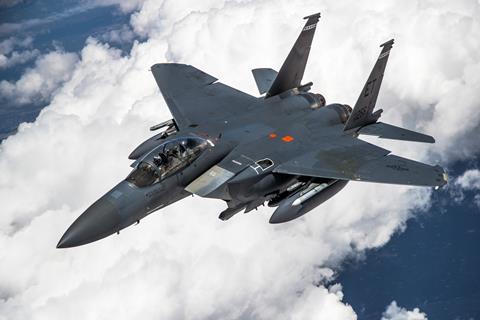A recent think tank report suggests that the US Air Force (USAF) needs to substantially upgrade its force structure in Guam and Okinawa, while another warns about the danger posed by hardened Chinese air bases near Taiwan.
A new report from the Center for Strategic and Budgetary Assessments (CSBA) calls for increased intelligence, surveillance and reconnaissance (ISR) capabilities in both Guam and Okinawa, as well as sufficient combat assets to conduct retaliatory strikes against China in the event of a conflict.

“Okinawa is one of the most vulnerable hubs, due to its close proximity to large volumes of missiles and munitions from the [People’s Liberation Army],” contend the authors of the CSBA report, Carl Rehberg and Josh Chang.
“The main focus of the Okinawa initiatives is a dramatic increase in power projection and counterstrike capabilities, along with accompanying enhancements to ISR, maritime surveillance, and early-warning to defend against multi-axis attacks.”
In addition to ground-based defensive measures, they call for Boeing F-15EXs to replace the ageing F-15C/Ds that are being withdrawn from the Island. They see a need for 12 F-15EXs by 2025, and over 24 by 2030.
While the 24 F-15EXs will not fully replace the 54 F-15C/Ds that will be drawn down, the resources freed by the departing legacy fighters could support a large fleet of dispersed low-cost attritable combat aircraft.
The F-15EXs should be equipped with hypersonic cruise missiles, and weapons such as the Lockheed Martin AGM-158 JASSM (Joint Air-to-Surface Standoff Missile) and AGM-158C LRASM (Long Range Anti-Ship Missile).
In addition, it calls for General Atomics Aeronautical Systems MQ-9 Reapers to provided Okinawa with cruise missile defence, airborne early warning, and maritime surveillance.
The report makes similar suggestions for Guam, with 12-18 F-15EXs by 2030, attritible aircraft, and MQ-9s. It also calls for the permanent deployment of Boeing B-1B or B-52H bomberrs to the island base, pending the eventual deployment of the Northrop Grumman B-2.
“The lack of a credible and capable forward presence means that any crisis would force Washington to surge forces from outside the theater, which would meet stiff opposition from a variety of PLA counter-intervention plans,” says the CSBA.
Separately, a report by the Mitchell Institute warns about the threat posed by hardened Chinese air bases located just across the Taiwan strait from Taiwan.
The report, authored by Daniel Clayton Rice, observes that large waves of obsolete Chinese fighter jets could have been modified for unmanned operations, and be used in a first wave attack against the island nation, helping to exhaust valuable air defence munitions.
These would be followed by more advanced Chinese fighters with precision munitions, operating from the bases vacated by the earlier unmanned combat air vehicle wave.
The existence of these hardened bases so close to Taiwan, as well as China’s other hardened bases, suggest that the USAF may require more strike capacity than is now called for.

















































